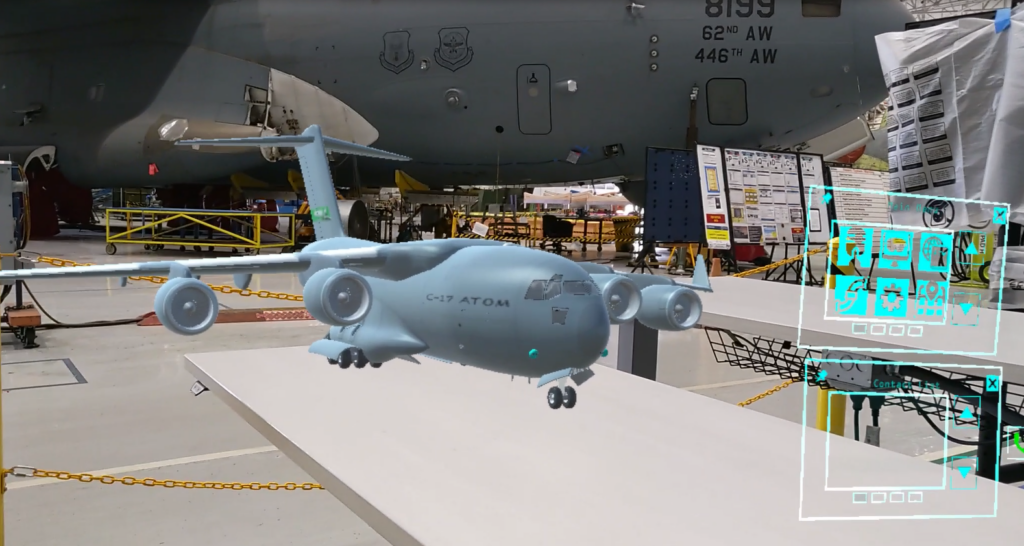
Boeing hopes to leverage 5G technology to improve aircraft maintenance and increase safety for military technicians. (Photo: Boeing)
Boeing is aiming to increase military aircraft mission capable rates and increase military technician safety through two efforts leveraging 5G technology—Autonomous Aircraft Inspection (AAI), using drones to take high-resolution photos of aircraft to spot damage, and Augmented Training Operations Maintenance (ATOM), which uses a Microsoft Hololens to allow military forces “secure reach back” to industry representatives to help fix parts.
“The [AAI] pictures that are being taken and the data being captured and analyzed is immensely valuable so that’s the big strategic sustainment value of what we’re doing–and the operational impact of keeping young airmen off the tail, or when they go up to the tail they know what they’re looking for,” Scott Belanger, team leader for next generation product support for Boeing Global Services and a retired U.S. Air Force colonel/logistician, said during a virtual interview on Aug. 15.
“Right now, 50 percent of all damage, when humans do the [aircraft] inspection, is missed—commercial and DoD,” he said. “That’s the industry standard. In DoD, that [percentage] may be a little higher because their technicians are more junior, less experienced. The small test we’ve run the past two years at [Joint Base Pearl Harbor] Hickam, we’re at 73 percent, and that’s pretty good, considering we started at 50 percent. We think we’re going to get into the high 70s as far as capturing anomalies and damage.”
AAI inspections are hangar-only but may expand to outdoor ones at Hickam next year.
The AAI effort began in 2021 and has used drones by a Pittsburgh-based small business, Near Earth Autonomy, to inspect C-17 cargo planes at Hickam. The aft sections of the drones have Boeing’s Automated Damage Detection Software (ADDS).
Verizon is constructing a 5G network on Oahu, but the network is not yet complete.
AAI has thus relied upon credit card-sized, government-provided “puck” mobile phones to emulate a 5G network until the Oahu project is finished.
By contrast, the ATOM experiment is using the Verizon 5G network. “They have positioned the experiment on the flight line on a C-17,” Belanger said. “Verizon mounted some of the emitters for the network on a really old World War II-era smokestack on base to get the right coverage down.”
Alli Locher, the inspection group lead for Near Earth Autonomy, said during the Aug. 15 virtual interview that AAI “is not going to eliminate the need for visual inspections.”
AAI “is going to make [inspection] more flexible and decrease risk to airmen,” she said. “We’re taking the same airman that’s either on a lift or walking the aircraft and putting him on the ground and enabling him to do his job quicker and safer.”
Locher said that 4G and Long Term Evolution (LTE) networks are insufficient for military data needs. “We have large photos that, in order to accelerate and take full advantage of, we want to be able to store them on the cloud,” she said. “You’re looking at uploading 61 megapixel photos over a network and need that network to be able to handle large files.”
Near Earth Autonomy’s work on drone inspections for aircraft maintenance began in 2017 when NEA collaborated with Boeing on a research and development project for C-17s at Boeing’s maintenance, repair, and overhaul (MRO) plant in San Antonio.
Inducting a C-17 into an Air Force depot or modification process at Boeing’s MRO or to the Air Force’s Warner Robins Air Logistics Center in Georgia “takes about 180 hours,” Belanger said. “We think we can cut that substantially down [to] around 50 [hours] and get a much more accurate assessment of the aircraft before it gets sent [to depot].”
“That’s a week where the aircraft is outside being externally inspected by a team of six to eight technicians,” he said. “They’re taking digital photos by hand, but the photos aren’t the same every time and don’t have the quality the drone’s [photos] have, and it’s dangerous. [Technicians] are getting in lifts and putting on harnesses and having to get up on the multi-stories high T-tail. The [NEA] drone will inspect the upper surfaces of the [C-17] jet in about 30 minutes, and the photos coming off of it are analyzed by the Jedi software that NEA has and the aircraft damage detection system that we have which produces a report for the technician to show them where the damage is.”
Boeing plans to expand the AAI work to other aircraft, possibly to Navy aircraft at Whidbey Island, Wash., and other Air Force cargo planes, tankers, and bombers.
Boeing and NEA have teamed on “scanning in and beginning to establish the operational foundation for drones for [the] C-5,” Belanger said. “We just scanned in KC-135 and KC-46, and we’re laying down plans this year to get after B-52 and even P-8.”
Human technicians will still be a maintenance mainstay, since 80% of DoD aircraft, including the C-17 and the venerable B-52, are not digitally designed, model-based engineering (MBE) planes, Belanger said. MBE aircraft include the Air Force’s T-7A Red Hawk trainer and the U.S. Navy’s MQ-25 Stingray refueler–both by Boeing.
The AAI goal is “not to cut manpower,” but “to make the existing visual inspection more efficient, safer, and more beneficial to mission readiness,” Belanger said. “We are capturing over the past two years with C-17 at Hickam really a ‘poor man’s digital record’ for each [aircraft] tail. That’s a powerful tool when it comes to sustainment planning. That ‘by tail’ information is not being captured right now.”
“I think DoD is committed to it,” Belanger said of AAI. “They seem to be funding it every year, and, as long as they do, Boeing will be there with partners like NEA to try to get the warfighter technology that they need now, especially in the Pacific.”
This article was originally published by Defense Daily, a sister publication of Avionics International. It has been edited. Read the original version here >>